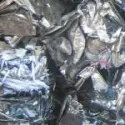BIR – The following article is based on the latest Stainless Steel & Special Alloys World Mirror produced by the BIR world recycling body for the benefit of its members. Visit www.bir.org to read the entire market analysis.
The anticipated pick-up in stainless steel product demand was struggling to materialise in the early part of the fourth quarter amid persistent uncertainty over economic prospects on both sides of the Atlantic. All areas of the world, with the exception of China, suffered a decline in stainless production when comparing the second quarter with the first three months of this year.
Preliminary figures from the International Stainless Steel Forum reveal that crude stainless steel production increased globally by 3.8% in the first half of 2011 and the belief is that the second half of the year may not witness an improvement on this level.
The January-June increase in production was restricted mainly to China where output climbed 13% whereas producers elsewhere in Asia saw their production decline 3%. Output in Europe was flat and production was slightly lower in the USA where flows of stainless steel scrap have been reduced because of a drop in manufacturing activity and reluctance among dealers to sell into the wholesale market.
Overall, lower demand for stainless steel scrap has been more than compensated by the lack of availability of raw material feedstock resulting from a drop-off in industrial output and unattractive prices. Against this backdrop, there is the prospect of China resuming imports of stainless steel scrap after a considerable absence because of higher costs relating to the production of nickel pig iron. Scrap supply remains tight not only in China but also across most of Asia.
In South Korea, it is envisaged that stainless steel production could expand from 2 million tonnes to nearer 2.2 million tonnes next year. In India, meanwhile, stainless steel mills operated at around 90% of capacity during the second and third quarters of 2011 but the wider economic worries and nickel volatility have led subsequently to a 40-50% decline in order levels in some instances; mill scrap stocks, particularly of the 300 series, reflect this sluggish demand for their end products. And in the Middle East, the government of Jordan has announced a decision to impose a US$ 70 per tonne duty on exports of steel/stainless steel scrap.
There has been a continuation of the trend in Russia for stainless steel scrap dealers to switch their focus to the domestic market in the wake of stricter controls affecting exporters. However, problems in securing payments from the country’s scrap consumers are reportedly widespread.
In Europe, where increasing competition is reported from Asian stainless mills, the evidence is that the traditional autumn upturn has yet to kick in. Indeed, it is estimated that only around 70% of the continent’s capacity is currently being utilised. In Germany, for example, demand and price offers remain fragile as domestic industrial production forecasts continue to fall. Weak domestic demand and a high unemployment rate have undermined stainless demand in Spain although producers’ scrap ratios have remained high in a bid to minimise production costs.
Italy is continuing to produce stainless steel at around 70-75% capacity for flat products and 80-85% for long products, and is encountering no difficulties in selling such volumes. Collections are more of a problem but Italy has been able to import material from neighbouring countries where consumption is low. In France, scrap and turnings availability has remained poor during the second half of 2011 whereas there was a healthy sufficiency in Scandinavia during the third quarter. The largest stainless producer in the UK, namely Outokumpu, is working on a very short order book and duly trimmed its raw material requirements in the third quarter.
As for the superalloys, secondary titanium demand has declined and no improvement is envisaged for the remainder of 2011. In addition, the availability of an increasing number of scrap units around the world could continue to apply downward price pressure into next year. Meanwhile, the nickel-based alloy sector has been very steady this year and a busy but unspectacular start has been made to the fourth quarter. The high speed steel market slowed dramatically during the third quarter and prospects are described as ‘bleak’ for the fourth quarter as all key components are weakening.
Don't hesitate to contact us to share your input and ideas. Subscribe to the magazine or (free) newsletter.



